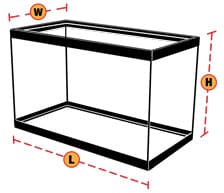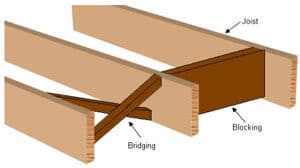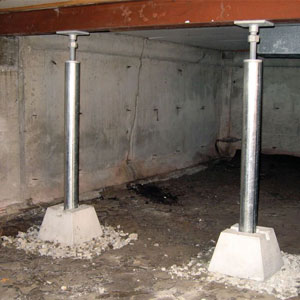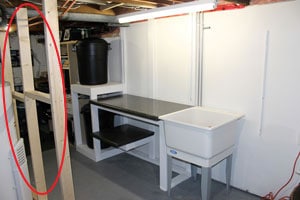When I was in my teens and early into my aquarium journey I realized how much aquariums weigh through a near catastrophe!
I had purchased a small 25 gallon aquarium as an upgrade for my Tropical Fish and sat it on top of my drawer unit, just like the smaller aquarium before it. No problems, right!?
Saltwater aquariums weigh 8.56 lbs or 3.88kg per gallon and 2.26 lbs or 1.03kg per liter.
Freshwater aquariums weigh 8.34lbs or 3.78kg per gallon and 2.20 lbs or 1.00kg per liter.
The empty weight of the tank, stand, canopy, substrate, and rock is in addition to the weight of the water.
My little 25 gallon freshwater aquarium weighed in at close to 200lb. and my cheap set of drawers were not happy! From that point on, every aquarium I owned had the manufacturer’s recommended stand!
Aquarium Water Weights
Saltwater Weighs:
8.56 lb. / 3.88 kg Per US Gallon
2.26 lb. / 1.03 kg Per Liter
Freshwater Weighs:
8.34 lb. / 3.78 kg Per US Gallon
2.20 lb. / 1.00 kg Per Liter
Below is a guide to glass saltwater and freshwater aquarium weights by volume:
| AQUARIUM VOLUME | SALTWATER WEIGHT | FRESHWATER WEIGHT | EMPTY WEIGHT |
|---|---|---|---|
| 5 Gal / 19 liters | 43 lbs / 16 kg | 42 lbs / 19 kg | 7 lbs / 3 kg |
| 10 Gal / 38 liters | 87 lbs / 40 kg | 84 lbs / 38 kg | 11 lbs / 5 kg |
| 15 Gal / 57 liters | 128 lbs / 58 kg | 125lbs / 56 kg | 19 lbs / 9 kg |
| 20 Gal / 76 liters | 172 lbs / 77 kg | 167 lbs / 75kg | 25 lbs / 11 kg |
| 25 Gal / 95 liters | 214 lbs / 96 kg | 209 lbs / 94 kg | 32 lbs / 15 kg |
| 30 Gal / 114 liters | 257 lbs / 116 kg | 250 lbs / 113 kg | 42 lbs / 19 kg |
| 35 Gal / 133 liters | 300 lbs / 150 kg | 292 lbs / 131 kg | 46 lbs / 21 kg |
| 40 Gal / 152 liters | 342 lbs / 154 kg | 334 lbs / 150 kg | 56 lbs / 25 kg |
| 45 Gal / 170 liters | 385 lbs / 173 kg | 375 lbs / 169 kg | 68 lbs / 31 kg |
| 50 Gal / 190 liters | 428 lbs / 193 kg | 417 lbs / 188 kg | 70 lbs / 32 kg |
| 55 Gal / 208 liters | 471lbs / 212 kg | 459 lbs / 206 kg | 78 lbs / 35 kg |
| 65 Gal / 246 liters | 556 lbs / 250 kg | 542 lbs / 244 kg | 90 lbs / 41 kg |
| 75 Gal / 284 liters | 642 lbs / 289 kg | 626 lbs / 281 kg | 98 lbs / 44 kg |
| 90 Gal / 341 liters | 770 lbs / 346 kg | 751 lbs / 338 kg | 135 lbs / 61 kg |
| 120 Gal / 455 liters | 1,027 lbs / 462 kg | 1,001 lbs / 450 kg | 191 lbs / 87 kg |
| 150 Gal / 569 liters | 1,284 lbs / 578 kg | 1,251 lbs / 563 kg | 281 lbs / 127 kg |
| 180 Gal / 682 liters | 1,541 lbs / 693 kg | 1,501 lbs / 676 kg | 282 lbs / 128 kg |
| 210Gal / 796 liters | 1,798 lbs / 809 kg | 1,751 lbs / 788 kg | 343 lbs / 156 kg |
| 240 Gal / 910 liters | 2,054 lbs / 924 kg | 2,002 lbs / 901 kg | 365 lbs / 166 kg |
| 280 Gal / 1,061 liters | 2,397 lbs / 1079 kg | 2,335 lbs / 1051 kg | 402 lbs / 182 kg |
| 300 Gal / 1,137 liters | 2,568 lbs / 1156 kg | 2,502 lbs / 1126 kg | 446 lbs / 202 kg |
Once you have the weight of the water you will also need to add the empty weight of the aquarium, the stand, the sand and the Live Rock/Dry Rock you add to the system.
How to Accurately Calculate Aquarium Weight & Volume
Calculating the weight and volume of your new aquarium is really simple and is essential for you to know. Knowing the weight is one part, but when it comes to dosing and treating your aquarium with medication, you need to know the volume in your system.
Knowing how to calculate volume will also help if you add on a future sump or frag tank to your system.
Multiply Length x Width x Height

Calculating Aquarium Volume:
Gallons:
48″ x 18″ x 21″ = 18,144 Cubic Inches
18,144 x 0.004 = 73 Gallons
Litres:
122cm x 46cm x 53cm = 297,436 Cubic Centimeters
297,436 / 1000 = 297 Liters
Calculating Aquarium Weight:
Pounds:
Volume ( Gallons ) x 8.56 for Saltwater
Volume ( Gallons ) x 8.34 for Freshwater
73 Gallons x 8.56 = 625 lb. Saltwater
73 Gallons x 8.34 = 609 lb. Freshwater
Kilogrammes:
Volume ( Litres ) x 1.024 for Saltwater
Volume ( Litres ) x 1.000 for Freshwater
297 Litres x 1.024 = 304 kg for Saltwater
297 Litres x 1.000 = 297 kg for Freshwater
Calculating Custom Shaped Aquariums
It’s back to Math Class Ladies & Gentlemen! Who can remember areas and volumes of shapes? It’s just the same here!
- Calculate the area
- Calculate the volume
- Calculate the weight
Don’t worry I’m not going to be cruel and make you get out the pen, paper and calculator! There is an awesome calculator that does it all for you!
Click Here to visit the Volume Calculator
Once you have your volume, you can use the equations above to help you find out the weight. Don’t forget to add in the weight of your sump if that’s in the stand too!
Floor Strength Required For An Aquarium
When I was in the planning stages of my aquarium I knew it was going to be heavy. It’s only a 75 gallon aquarium, but I knew it was going to weigh around 650 lb., add the weight of the stand, sand, and rock, it would be close to 750-800 lb.
The other consideration I had was that people like to look at your aquarium when you have guests, so now you have 4- 6 adults standing in the same area and you have now added another 800-1200 lb. in weight.
A total weight of up to 2000 lb. within an 8ft square area of my floor. I’m no structural engineer but I wanted to know the floor in my 100-year-old house would take the load.
North American Building Code
Below my aquarium, I had a basement with my floor joists being 12″ apart. I researched and found that by placing the aquarium as close to the outside wall this would be the strongest point of the joists.
Spanning as many joists as you can helps to distribute the load too.
A check of your local building codes will help you ascertain exactly what your floor should be able to support, but in general 12″ spans should support around 40 pounds per square foot. This is a theoretical load averaged over the entire floor within your room.
Your aquarium only takes up a small portion of the floor space and depending on where that floor space is, you may need to support the joists from below or have additional structure added to your joists.
If you looking to install a large aquarium I would suggest you contact a structural engineer to come and survey the location just to be sure.
How To Support Floor Joists For An Aquarium
Most aquariums up to the 120 Gallon size should be fine in most homes. Once you start going up from that size there are things you can do to help support the floor under your aquarium, provided you can access the area of course!
- Place the aquarium close to an outside wall
- Place your aquarium across as many joists as you can
- Install blocking or bridging between your joists to prevent twisting


- Install Sister boards to increase individual joist strength
- Install support beams and posts under joists

For my setup, I built an additional 2×4 frame and placed it under my joists to help support the load, just in case!

Aquariums In Condo’s and Apartments
There are many aquarium owners who live in tower blocks who regularly ask this question. Is my aquarium too heavy for the concrete floor?
As we all know concrete is incredibly strong and the floors of a residential and commercial tower block are built to suit.
During my research, all I have been able to find is that they must meet the same 40 pounds per square foot loading as residential homes. I have personally seen large aquariums over 120 gallons in offices and workplaces with no problems, but that doesn’t mean anything!
Two things to consider with tower buildings:
- Have a structural engineer come and survey your space if you’re planning a big aquarium
- Check with the rules and regulations of the tower block owners. They may limit the size of the aquarium you can install and may require you to have additional insurance to cover any leaks or damage.
Other Considerations
Many aquarium owners add a sump to their aquarium and where do many of these sumps get installed? In the stand, under the aquarium!
Now you have just added another 50 gallons of water and 400 lb. to your 150 gallon reef tank system!
In all my years in this industry, I have not come across anyone who’s floor has collapsed, but that’s not to say it has not happened. Like everything else in this hobby, Planning Is King!
The bigger the tank you can afford to run, the healthier and more stable it will be for its inhabitants but, make sure your floor is able to take the load. The last thing you want is to find out 5 years down the line the floor joists have started to split under your tank!
One last thing to consider is if you are in an earthquake zone. Is your tank stable, will it rock, will a dynamic load of a rocking tank add additional stress to your stand and floor structure?
These are just somethings you might want to consider when planning your next tank, as we all know we don’t go down in tank sizes ;D
Further Reading
You may find the following articles helpful too:


